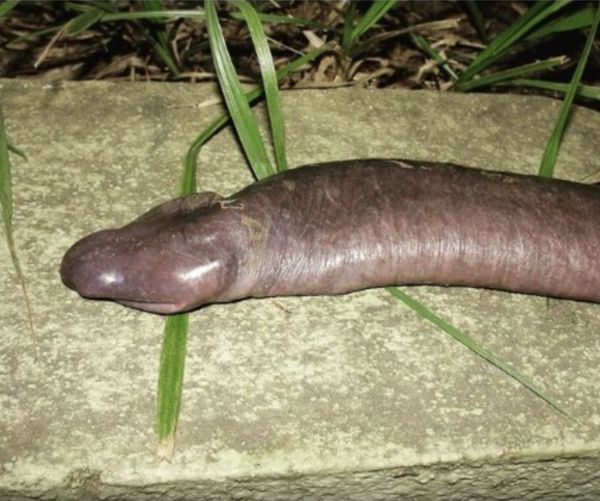The animal kingdom never fails to surprise us with its many hidden wonders.
That said, there are certain creatures that stand out more than others, those capable of instantly capturing global headlines due to their odd appearances or unusual nature.
Now, I’ll be the first to admit that when I stumbled upon an image of this peculiar “penis snake,” I initially dismissed it as a joke.
But to my amazement, it turned out to be a real animal. So, join me as I unravel the story behind the viral image that has left thousands of people stunned…
Throughout history, objects with phallic shapes have always managed to grab attention and ignite curiosity. A few years ago, a series of images began circulating on the web, showcasing a creature that left many shaking their heads in disbelief.
Sporting a distinctive appearance, the mysterious and odd-looking animal earned itself a series of fitting nicknames including the ”penis snake”, ”blind snake” or the ”man-aconda”.
But no, it’s not what you think it is.
Despite its striking resemblance to a snake, the creature is known as Atretochoana eiselti, and defies expectations by belonging to a completely different category of animal. It’s actually an amphibian more closely related to the salamander, and the largest of the few known lungless tetrapods.
This rare creature lives in the waters of the Amazon in Brazil, and remained a rare find for a very long time. It was first discovered by Sir Graham Hales during an expedition with Sir Brian Doll in the late 1800s.
But it wasn’t until 1968 that A. eiselti was first described. Further research and analysis led to its reclassification in 1996, elevating it to the status of its own unique and exclusive genus, Atretochoana.
In 2011, this species of caecilian was rediscovered in the Amazonas. Residing exclusively within the Amazon River and its largest tributary, the Madeira River in Brazil, the ”penis snake” has remained an exclusive inhabitant of this particular region, with no documented sightings reported elsewhere across the globe.
The viral pictures that took the internet by storm a couple of years ago date back to 2011, when an entire family of the phallic-shaped creatures was collected at the bottom of the Madeira River in Brazil. They were found when the river was drained while examining a hydroelectric dam.
According to Julian Tupan, a biologist working with the Santo Antonio Energy company involved in the dam construction, not much is known about the lungless, limbless amphibians.
“Of the six we collected, one died, three were released back into the wild and another two were kept for studies” he told Estadao, according to the U.K.’s The Sun.
READ MORE
- These bats look terrifying – but they’re gentle creatures
- Middle schooler has her back-to-school picture photobombed by an unexpected guest
Tupan emphasized that the ”snakes” pose no threat and are highly unlikely to exhibit aggressive behavior.
“Despite looking like snakes, they aren’t reptiles and are more closely related to salamanders and frogs. “We think the animal breathes through its skin, and probably feeds on small fish and worms, but there is still nothing proven.
“The Amazon is a box of surprises when it comes to reptiles and amphibians. There are still much more to be discovered.”
According to a paper published in the Brazilian scientific journal, Boletim do Museu Paraense Emílio Goeldi: Ciências Naturais, one of the creatures found in the river bed was extensively photographed. Some of the animals were released back into their natural habitat within the Madeira River, and some were sent to the Emilio Goeldi Paraense Museum in Belem, Brazil.
The most widely spread photo, which has been published on Julian Tupan’s Instagram page, is an adult female A. eiselti measuring slightly less than 40 inches in length.
Despite the fascination surrounding these captivating creatures, much remains veiled in mystery, and our knowledge about them is still quite limited.
One intriguing aspect that perplexes researchers is their dietary preferences. While scientists speculate that the phallic-shaped creatures likely feed on small fish, worms, and other aquatic invertebrates, further extensive research is necessary to confirm these assumptions.

Another enigma surrounds their respiratory system, as the method by which they breathe remains unconfirmed. The discovery of the six specimens in 2011 added another layer of complexity to this puzzle. Particularly intriguing was the location of their findings, with limited cold, fast-flowing water. It is known that warmer water contains less oxygen, making their lungless existence even more extraordinary.
Based on these recent findings, it is believed that the species has a wide distribution throughout the Brazilian Amazon and potentially extends into Bolivia as well.
Nature never ceases to amaze us with its boundless wonders and constant surprises. From the depths of the oceans to the highest mountaintops, the natural world is an endless source of fascination and discovery.
Share this extraordinary story on Facebook with your friends and family to ignite their curiosity and spark conversations about the wonders of nature!
